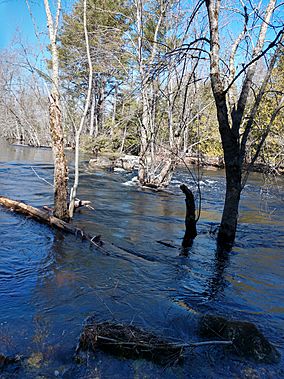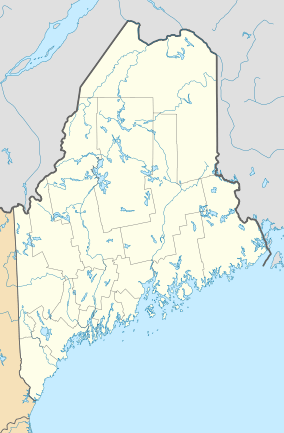Hirundo Wildlife Refuge facts for kids
Quick facts for kids Hirundo Wildlife Refuge |
|
|---|---|
|
IUCN Category IV (Habitat/Species Management Area)
|
|

The Pushaw Stream in Hirundo Wildlife Refuge in April 2018.
|
|
| Location | Penobscot County, Maine, United States |
| Nearest city | Old Town, ME |
| Area | 2,402 acres (972 ha) |
| Established | 1965 |
| Governing body | University of Maine |
The Hirundo Wildlife Refuge is a special place in Maine where nature is protected. It covers about 2,402 acres (972 ha) of land along the Pushaw and Dead streams in Penobscot County. This refuge was started in 1965 by Oliver Larouche. He began it from his parents' small 3 acres (1.2 ha) camp.
Later, in 1983, Oliver and his wife June gave the refuge to the University of Maine. It's like a living outdoor laboratory where scientists study nature. Hirundo is located just below Pushaw Lake. It also includes part of the Caribou Bog wetland, which is one of the largest wet areas in Maine. The refuge is also home to the Hirundo Site. This is a very old Native American living area. It shows that people lived there for about 4,500 years!
Fun Things to Do at Hirundo
The Hirundo Wildlife Refuge is open every day from 9:00 AM until the sun sets. The best part is, it's completely free to visit!
You can enjoy many outdoor activities here:
- Go canoeing on the streams.
- Try geocaching, which is like a treasure hunt using GPS.
- Take amazing photos of nature and wildlife.
There are also 7 miles (11 km) of hiking trails to explore. Three of these trails have special brochures to guide you. In winter, when there's snow, you can go snowshoeing or cross-country skiing.
To keep the refuge safe and beautiful, some things are not allowed:
- Hunting or trapping animals.
- Smoking or making fires.
- Bringing pets or bicycles.
- Using motorized vehicles.
- Digging or picking plants and rocks.
Discovering Ancient History
The Hirundo archaeological site is a very important place. It was one of the first spots in eastern Maine to show signs of people living there a long, long time ago. This was around 3000 BCE, which is about 5,000 years ago!
People first found this site by accident in 1971. Then, experts started digging there carefully from 1972 to 1975. They found many interesting things. These included stone tools and special pointed stones. They also found heavy stone weights called "plummets." These were probably used for fishing. Because of its importance, the Hirundo site was added to the National Register of Historic Places in 1975.


